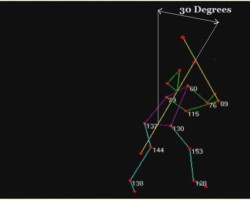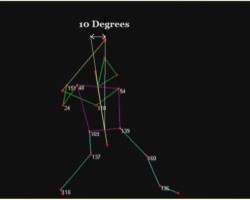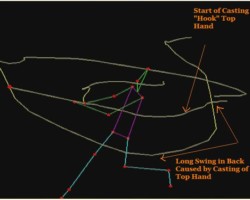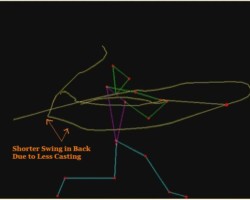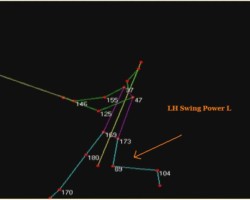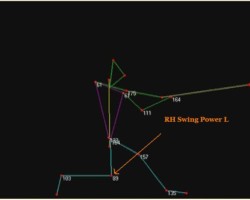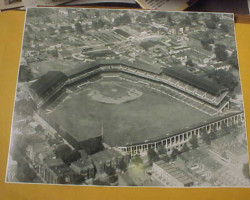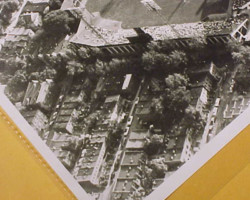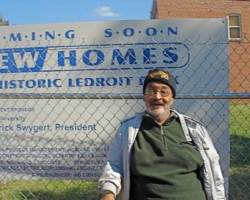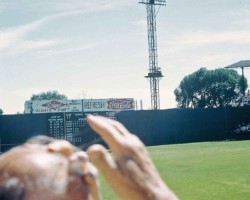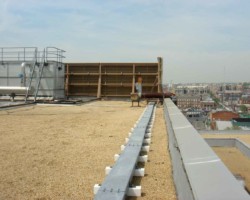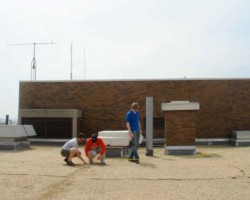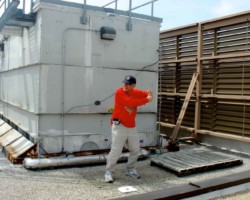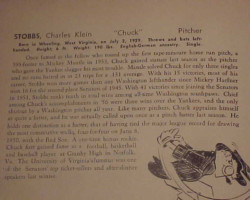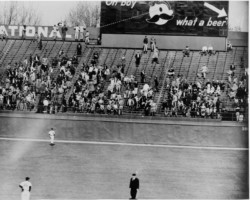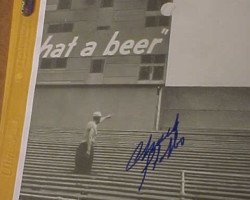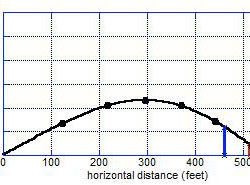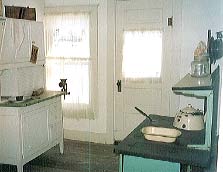<div id="tab-container"><!-- [et_pb_line_break_holder] --><div class="tablet"><!-- [et_pb_line_break_holder] --><div class="tab"><!-- [et_pb_line_break_holder] --><h1 class="title">Chapter One</h1><!-- [et_pb_line_break_holder] --><h2 class="title">March 26, 1951<br /><!-- [et_pb_line_break_holder] -->The Whole World Opened Up<!-- [et_pb_line_break_holder] --></h2><!-- [et_pb_line_break_holder] --><p><!-- [et_pb_line_break_holder] -->On March 20, 1951, shortly after arriving in Los Angeles for the beginning of their spring training tour of California, the World Champion New York Yankees visited the lot at MGM where Betty Grable was rehearsing dance numbers for her newest flick. A PR still, later published in Movie Fan magazine, was taken to commemorate the occasion. There's Yogi Berra front and center wearing a garish paisley sports shirt as bright as his smile, with a collar as wide as his ears and Grable on his welltailored arm. There's The Scooter, Phil Rizzuto, the unlikely MVP of the 1950 season, and his double-play partner, second baseman Jerry Coleman;Johnny Hopp, Johnny Mize, and big Joe Collins offering Grable his right arm.</p><!-- [et_pb_line_break_holder] --><!-- [et_pb_line_break_holder] --><p>In the back row, like a schoolboy who'd wandered into the wrong class picture, stands the rookie Mickey Mantle, his features as unformed as his future. He gazes over Grable's shoulder, his blond hair smartly parted, cowlick neatly slicked, necktie tautly knotted.</p><!-- [et_pb_line_break_holder] --><!-- [et_pb_line_break_holder] --><p>Mantle and his roommate, Bob Wiesler, were the only rookies in the bunch, both movie buffs. They couldn't understand why more of the veteran players hadn't jumped at the chance to go to Hollywood. They met Esther Williams, Red Skelton, Howard Keel, and the guy who later played Miss Kitty's bartender on Gunsmoke. They saw Debbie Reynolds hurrying down the hall carrying two fur coats and called out, "Hiya, Deb!" Mantle wrote home to his Oklahoma sweetheart about the starlets who returned his hello. "Wasn't any as pretty as you."</p><!-- [et_pb_line_break_holder] --><!-- [et_pb_line_break_holder] --><p>It was a big time for Mickey Mantle. His childhood friend from Commerce,Nick Ferguson, who had migrated west after high school, drove up from San Diego in his old '42 Plymouth to show him the California coast. Ferguson wanted his Okie buddy to see the Pacific. They went straight out Wilshire Boulevard to the Santa Monica Pier. It was Mantle's first opportunity to feel the surf and sand between his toes. But he did neither. Baseball was the only thing on his horizon. All he cared about was getting to the ballpark on time.</p><!-- [et_pb_line_break_holder] --><!-- [et_pb_line_break_holder] --><p>Del Webb, the Yankees' entrepreneurial co-owner, had contrived that spring to switch training camps with the New York Giants. Webb was a Phoenix real estate developer, ahead of his time in grasping the westward rush of postwar America. Sporting News reported that he was considering selling his stake in the Yankees to his partner Dan Topping as part of a plan to extend major league baseball beyond the Mississippi.Bringing the Yankees to train in Phoenix allowed him to play the big shot in his hometown. Then he sent them barnstorming up and down the California coast in order to showcase Joe DiMaggio in the Clipper's home state and whet the appetite for big league ball. The schedule called for thirteen games in California, mostly against Class AAA Pacific Coast League teams, with stops at Glendale, manager Casey Stengel's hometown;in Oakland, where Stengel had managed the Oaks before being promoted to the Yankees' job; at Seals Stadium in San Francisco, where DiMaggio had made his name; and finally at the University of Southern California against the Trojans, better known for their gridiron exploits. That spring was the last time the Yankees would train anywhere other than Florida.</p><!-- [et_pb_line_break_holder] --><!-- [et_pb_line_break_holder] --><p>It also marked the opening act of one of baseball's—or Broadway's—greatest hits, an SRO psychodrama with a very long run.Stengel had seen Mantle for the first time a year earlier at a pre–spring training camp held in Phoenix for the top prospects in the Yankees system.The kid, just eighteen, had missed the team bus to the practice field. He was standing with a teammate, Cal Neeman, neither of them knowingwhat to do, when a taxi pulled up. "Well, hop in, boys," Stengel said, "we'll go to the park."</p><!-- [et_pb_line_break_holder] --><!-- [et_pb_line_break_holder] --><p>Neeman recalled, "And we're ridin' along, and he wants to know who's in the car. Well, we really didn't want to tell him. I give him my name. He come to Mickey and says, 'Who are you?' And he says, 'I'm Mickey.' And he says, 'Oh, you're that kid that's all mixed up. You're not supposed to be able to run like that and hit the ball so far.'"</p><!-- [et_pb_line_break_holder] --><!-- [et_pb_line_break_holder] --><p>Mantle was all but invisible until the coaches said, "Take your marks . . ." Hank Workman, a prospective first baseman, recalled, "They were timing guys from home to first. Nobody noticed Mantle up to that. He was very quiet and extremely shy. He would pull his cap down so far over his brow that you could hardly see his face. Then he ran. And I swear he was going so fast you could still see the tufts of dust in the air from his footprints a couple of feet back from where he was."</p><!-- [et_pb_line_break_holder] --><!-- [et_pb_line_break_holder] --><p>Bunny Mick, one of Stengel's lieutenants, timed him from the left-handed batter's box to first base in 3.1 seconds, a new land-speed record.Workman also recalled Mantle's debut in intrasquad games: "The first time Mantle came up, he hit one a mile outta that ballpark. About three innings later he comes up again. The pitcher's changed, and he hits one a mile out the other way. And all he does after is, he trots out to shortstop in his non-ostentatious way with his hat pulled way down."</p><!-- [et_pb_line_break_holder] --><!-- [et_pb_line_break_holder] --><p>The camp was shut down when Commissioner Happy Chandler got wind of the big league instructors getting a head start on spring training. But Stengel had seen enough to see the future. "Mantle's at shortstop taking ground balls, throwing 'em by the first baseman—and outta the dugout comes Stengel," Workman remembered. "He's got a fungo bat in his hand, and he runs right at Mantle. He starts waving this bat at him, and he shoos him out into the outfield, and turns around and loudly announces to all the coaches and everybody that's assembled that this guy is gonna be a center fielder. 'I'm gonna teach him how to play center field myself, and I don't wanna see him at shortstop again.'"</p><!-- [et_pb_line_break_holder] --><!-- [et_pb_line_break_holder] --><p>But that's where he played for the 1950 Joplin Miners. His .383 battingaverage deflected attention from his 55 errors and he was named the Most Valuable Player of the Western League. In January 1951, The SportingNews hailed him as a "Jewel from Mine Country."</p><!-- [et_pb_line_break_holder] --><!-- [et_pb_line_break_holder] --><p>"Nineteen-year-old Mickey Mantle, dubbed by some big time scouts as the No. 1 prospect in the nation, will be off for Phoenix in a few weeks to display the talents that won him such raves from veteran talent hunters,"baseball writer Paul Stubblefield declared. And in a special box, The Sporting News announced the engagement of the Yankees' big catch—who "didn't cost a nickel"—to Miss Merlyn Louise Johnson of Picher, Oklahoma.</p><!-- [et_pb_line_break_holder] --><!-- [et_pb_line_break_holder] --><p>The groom to be was a no show when rookies reported to spring trainingcamp two weeks later. A reporter and photographer from the Miami Daily News-Record found Mantle at the Eagle-Picher motor pool anddelivered a message from Yankee farm director Lee MacPhail: "Where are you?"<!-- [et_pb_line_break_holder] -->Helping out the pump crew, came the reply, for $33 a week.</p><!-- [et_pb_line_break_holder] --><!-- [et_pb_line_break_holder] --><p>The Yankees hadn't sent him a train ticket, and Mantle wasn't a bonus baby likeSkowron ($25,000) and Kal Segrist ($50,000). His half brother, Ted Davis, used his Army discharge money to pay for Miss Johnson's engagementring. The photographer snapped a picture of the overall clad prospectwith the smudged grin leaning against a mining company truck. The next day, Tom Greenwade, who would forever be known as the scout who signed Mickey Mantle, showed up with his fare.</p><!-- [et_pb_line_break_holder] --><!-- [et_pb_line_break_holder] --><p>By the time Mantle got off the train in Phoenix, the Yankees' most heralded rookies—Bob Wiesler, Moose Skowron, Gil McDougald, Andy Carey, and Bob Cerv—were working on their baseball tans. They never forgot those early tastes and smells of the big time. For Al Pilarcik, an outfielder from Ohio, it was the scent of orange blossoms from the trees outside the team's motel. For Wiesler, it was the standing rib roast that circulated through the dining room on a rolling cart. Every night, waiters would lift the platter's heavy silver-plated hood and the kids would help themselves to a juicy slab of promise.</p><!-- [et_pb_line_break_holder] --><!-- [et_pb_line_break_holder] --><p>The early reports on Mantle were measured in tone. He was being groomed, considered, studied. Neither he nor his employers expected him to play in the big leagues in 1951. Never had anyone in the Yankee system made the leap from Class C to the majors after only two years in professionalbaseball. And Jackie Jensen, the California golden boy, was also waiting in the wings for DiMaggio to exit stage right.</p><!-- [et_pb_line_break_holder] --><!-- [et_pb_line_break_holder] --><p>But Stengel was watching, keeping a close eye on his new kid. "We'd go down through the lobby, Casey would always be sittin' there," Nick Ferguson said. "And he never said anything, but he was eyeballin' me like he knew I wasn't a player, and what was I doin' there with Mickey?"Spring is a season of profusion, especially for baseball writers, the inevitable consequence of sending grown men to Florida and Arizona with empty notebooks, a per diem—and no wives. Red Smith rued the day he received a wire from Stanley Woodward, his editor at the New York Herald Tribune, ordering him to quit "godding up those ballplayers."Nonetheless, in the spring of 1951, Mickey Mantle was elevated and beatified.</p><!-- [et_pb_line_break_holder] --><!-- [et_pb_line_break_holder] --><p>In the thin Arizona air, his home runs soared and florid prose burst forth from fallow typewriters like desert wildflowers. Just a week after Mantle arrived in camp, Ben Epstein, the effusive beat writer for the New York Daily Mirror, wrote, "Thank the fates for Arizona's ambrosial air. It's practically necessary to fuel one's lungs with the stuff if you want to stay in fashion and carry on about Mickey Mantle. Latest estimates hoisted the Yankee oakie doakie as the eventual successor to Joe DiMaggio."Bad weather during the first days of camp—snow, even—forced the players indoors. Indolent scribes still had to churn out copy. Encomiums lit up the Western Union wires: "Rookie of the Eons," "Magnificent Mantle," "Mighty Mickey," "Young Lochinvar," "Commerce Comet," "Oklahoma Kid," "Colossal Kid," "Wonder Boy," "One-Man Platoon," "The Future of Baseball."</p><!-- [et_pb_line_break_holder] --><!-- [et_pb_line_break_holder] --><p>Pete Sheehy, the clubhouse man and guardian of Yankee succession, assigned the lockers and the uniform numbers—the Yankees were the first team to do that. Sheehy had gone to work for the club when he was fifteen, summoned to his calling while waiting for the Stadium gates to open one day in 1927—and stayed until his death fifty-nine years later. The Yankeelocker room is named after him. He was the institutional memory of the club, who divulged nothing. He fetched hot dogs and bicarb for The Babe and joe for Joe D.; he informed a historically challenged rookie that George Herman Ruth's number 3 was not available, nor was Henry Louis Gehrig's 4. As for 5, everyone knew 5 was still working on immortality. Sheehy gave Mantle 6. "The law of mathematical progression," the Yankees'public relations man Red Patterson called it.</p><!-- [et_pb_line_break_holder] --><!-- [et_pb_line_break_holder] --><p>Veterans reported on March 1. Archie Wilson, an outfielder returning from military service, arrived to find both beds in his assigned room taken. Archie's widow, Sybil Wilson, recalled that as her husband put his things down on a roll-away, Mantle rose from his bed and said, "You're not going to sleep on the cot." He would take it—Wilson was an Army vet and his senior.<!-- [et_pb_line_break_holder] -->On March 2, Stengel announced that he was moving Mantle to the outfield. The next day, DiMaggio announced that the 1951 season would be his last. His throwing shoulder was sore, his left knee was swollen, and his pride was smarting. All those questions didn't help, either. Louella Parsons, the dominatrix of Hollywood gossip, wanted to know about a possible reconciliation with his estranged wife, Dorothy. The baseball writers wanted the dope on the new kid. So DiMaggio threw them all a curve.</p><!-- [et_pb_line_break_holder] --><!-- [et_pb_line_break_holder] --><p>His retirement was on the horizon, but the Yankees had no idea an announcement was coming that day. "What am I supposed to do, get a gun and make him play?" Stengel groused. Overnight, Mantle went from a good story to the story. "When they'd go into the hotel lobbies, all the newspaper people would flock to Mickey," Sybil Wilson recalled. "He would get down behind Archie and squat down so they wouldn't see him. He was so scared of them."</p><!-- [et_pb_line_break_holder] --><!-- [et_pb_line_break_holder] --><p>Tommy Henrich, Old Reliable, was assigned the task of turning him into an outfielder, teaching him how to gauge the angle of the ball off the bat; how to position his body to catch the ball on his back foot and get rid of it in one smooth motion; how to react to a drive hit straight at him. His arm was plenty strong—legend had it that minor league ballparks refused to sell tickets behind first base when Mantle was patrolling the infield or put chicken wire up to protect the spectators. Delbert Lovelace, a friend from sandlot ball back home, was on the receiving end of more than one errant heave: "One time he let the ball loose, and it looked like surely that ball was goin' to drop into the dirt, and I put my glove down, and it hit me on the wrist above my glove." </p><!-- [et_pb_line_break_holder] --><!-- [et_pb_line_break_holder] --><p>The seams of the baseball were engraved in his flesh.</p><!-- [et_pb_line_break_holder] --><footer><!-- [et_pb_line_break_holder] -->© 2010 Jane Leavy.<!-- [et_pb_line_break_holder] --></footer><!-- [et_pb_line_break_holder] --></div><!-- [et_pb_line_break_holder] --></div><!-- [et_pb_line_break_holder] --></div>
